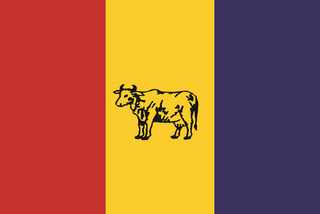
The Nepali Congress is a social democratic political party in Nepal and become the largest party in the country. The party has 870,106 members as of the party's 14th general convention in December 2021, making it the largest party by membership in Nepal. In June 2023, the party started online membership since the emergence of youth leaders in vital posts to attract youths to the party. The party is led by former prime minister, Sher Bahadur Deuba since the party's thirteenth general convention in 2016. The party won 89 seats in the 2022 general election and is currently the largest parliamentary group in the House of Representatives.

The Rastriya Prajatantra Party is a constitutional monarchist and Hindu nationalist political party in Nepal.

There are three types of elections in Nepal: elections to the federal parliament, elections to the provincial assemblies and elections to the local government. Within each of these categories, there may be by-elections as well as general elections. Currently three electoral systems are used: parallel voting for the House of Representatives and provincial assemblies, single transferable vote for the National Assembly, and first-past-the-post for local elections.

The House of Representatives, commonly known as Pratinidhi Sabha, is one of the houses of the Federal Parliament of Nepal, with the other house being the National Assembly. Members of the House of Representatives are elected through a parallel voting system. They hold their seats for five years or until the body is dissolved by the President on the advice of the council of ministers. The house meets at the International Convention Centre in Kathmandu.
General elections were held in Nepal on 12 May 1991, to elect 205 members to the House of Representatives. The elections were the first multi-party elections since 1959. The 1990 Nepalese revolution successfully made King Birendra to restore a multi-party system after King Mahendra had established the Rastriya Panchayat when he dissolved the parliament in December 1960.

The Federal Parliament of Nepal is the bicameral federal and supreme legislature of Nepal established in 2018. It consists of the National Assembly and the House of Representatives as parallel houses.

Rastriya Janamorcha is a political party in Nepal. It was originally founded in 1995 as the legal front of Communist Party of Nepal (Masal). Former Deputy Prime Minister, Chitra Bahdur KC is the chairman of the party.

The Chairperson of the National Assembly in Nepal is the presiding officer in the Nepal's upper house of parliament, the National Assembly. The position of Chairperson holds significant importance in the legislative process, presiding over the proceedings, maintaining order, and ensuring fair debate and discussion. The current speaker is Narayan Prasad Dahal since 12 March 2024.

The Rastriya Panchayat was the legislature of the Kingdom of Nepal from during the panchayat era from 1962 to 1990. Following the 1960 coup by King Mahendra, the enactment of the Constitution of 1962, made the Rastriya Panchayat the supreme legislative body in the country, replacing the Parliament of Nepal.
National Assembly elections were held in Nepal on 23 January 2020 across all seven provinces to elect the 18 of the 19 retiring members of the National Assembly. According to Article 86 of the Constitution of Nepal 2015, one third of the members of the National Assembly are elected every two years through an electoral college. Following the full implementation of the house in 2018, one-third of the members chosen by drawing a lottery retired after only two years.

The First Federal Parliament of Nepal, consisting of the House of Representatives and the National Assembly, was elected via the 2017 legislative, provincial and local elections.
National Assembly elections were held in Nepal on 26 January 2022 in order to elect 19 of the 20 retiring Class II members of the National Assembly, the upper house of the Federal Parliament of Nepal. Members of the National Assembly are elected through indirect ballot and serve six year terms with one third of the members retiring every two years. However, the retiring members served only four year terms due to the entire house being elected in 2018 when a lottery was held to determine two, four and six year term members.
Gopal Kumar Basnet is a Nepalese politician. He is also member of Rastriya Sabha and was elected from 2022 Nepalese National Assembly election.
Goma Devi Timilsina is a Nepalese politician and member of the CPN. She is also a member of the Rastriya Sabha and was elected in the 2022 Nepalese National Assembly election.
Rajendra Laxmi Gaire is a Nepalese politician and party member of Communist Party of Nepal. She is also member of Rastriya Sabha and was elected from 2022 Nepalese National Assembly election.

The Second Federal Parliament of Nepal, was elected by the 2022 general elections on 20 November 2022. The elections elected 275 Members of Parliament (MPs), 165 for each constituency and 110 through the party list, to the House of Representatives. The parliament convened for the first time on 9 January 2023.
National Assembly elections were held in Nepal on 25 January 2024 in order to elect 19 of the 20 retiring Class III members of the National Assembly, the upper house of the Federal Parliament of Nepal. Members of the National Assembly are elected through indirect ballot and serve six year terms with one third of the members retiring every two years.

The 2024 Ilam–2 by-election was held in the Ilam 2 constituency of Nepal on 27 April 2024. The by-election was held as the result of the death of the sitting member, Subas Chandra Nembang, chairman of the Constituent Assembly and vice–chair of the Communist Party of Nepal (UML), on 12 September 2023. It was held alongside by-election in the provincial assembly seat of Bajhang 1 (A).












